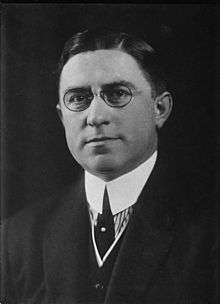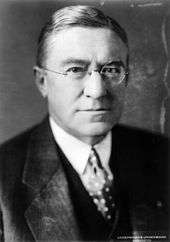Louis Thomas McFadden
| Louis Thomas McFadden | |
|---|---|
 | |
| Member of the U.S. House of Representatives from Pennsylvania's 14th district | |
|
In office March 4, 1915 – March 3, 1923 | |
| Preceded by | William D.B. Ainey |
| Succeeded by | William M. Croll |
| Member of the U.S. House of Representatives from Pennsylvania's 15th district | |
|
In office March 4, 1923 – January 3, 1935 | |
| Preceded by | Edgar R. Kiess |
| Succeeded by | Charles E. Dietrich |
| Personal details | |
| Born |
July 25, 1876 Granville Center, Troy Township, Bradford County, Pennsylvania |
| Died |
October 1, 1936 (aged 60) New York City |
| Political party | Republican |
Louis Thomas McFadden (July 25, 1876 – October 1, 1936) was a Republican member of the United States House of Representatives from Pennsylvania, serving from 1915 to 1935. A banker by trade, he was an opponent of the Federal Reserve System and was the chief sponsor of the 1927 McFadden Act, which limited federal branch banks to the city in which the main branch operates.
Early life
McFadden was born in Granville Center, Troy Township, Bradford County, Pennsylvania. He graduated from Warner's Commercial College (currently known as the Elmira Business Institute) in Elmira, New York. In 1892, he entered the employ of the First National Bank in Canton, Pennsylvania.
In 1899, he was elected cashier; he became its president on January 11, 1916 and served until 1925.[1]
McFadden served as treasurer of the Pennsylvania Bankers' Association in 1906 and 1907, and as president in 1914 and 1915. He was appointed in 1914 by the agricultural societies of the State of Pennsylvania as a trustee of Pennsylvania State College.[1]
Political career
In 1914, McFadden was elected as a Republican Representative to the Sixty-fourth Congress and to the nine succeeding Congresses.[1] He served as Chairman of the United States House Committee on Banking and Currency during the Sixty-sixth through Seventy-first Congresses, or 1920-1931.[1] Though re-elected without opposition in 1932, he lost to the Democratic nominee in 1934. He was an unsuccessful candidate for nomination in 1936.[1]
McFadden's main official legacy was the working on and the passing of the McFadden Act of 1927, limiting federal branch banks to the city in which the main branch operates. The Act sought to give national banks competitive equality with state-chartered banks by letting national banks operate branch banks to the extent permitted by state law. The McFadden Act specifically prohibited interstate branching by allowing national banks to branch only within the state in which they were situated. Although the Riegel-Neal Interstate Banking and Branching Efficiency Act of 1994 repealed this provision of the McFadden Act, it specified that state law continues to control intrastate branching, or branching within a state's borders, for both state and national banks.

McFadden was a "vociferous foe of the Federal Reserve",[2] which he claimed was created and operated by Jewish banking interests who conspired to economically control the United States. On June 10, 1932, McFadden made a 25-minute speech before the House of Representatives,[3] in which he accused the Federal Reserve of deliberately causing the Great Depression. McFadden also claimed that Wall Street bankers funded the Bolshevik Revolution[4] through the Federal Reserve banks and the European central banks with which it cooperated.
After the expulsion from Washington D.C. of the veteran petitioners of the Bonus Army, which he called "the greatest crime in modern history", McFadden moved to impeach President Herbert Hoover in 1932,[5] and he also introduced a resolution bringing conspiracy charges against the Board of Governors of the Federal Reserve. The impeachment resolution was defeated by a vote of 361 to 8; it was seen as a big vote of confidence to President Hoover from the House.[6] According to Time magazine McFadden was “denounced and condemned by all Republicans for his ‘contemptible gesture’."[2][6] The Central Press Association reported that he was "virtually read out of his party ... [had] his committee posts ... taken away from him…was ostracized by Republicans [and] called crazy ...".[7] Sen. David A. Reed (R-PA) said “We intend to act to all practical purposes as though McFadden had died”.[8]
In 1933, he introduced House Resolution No. 158, which included articles of impeachment for the Secretary of the Treasury, two assistant Secretaries of the Treasury, the Board of Governors of the Federal Reserve, and the officers and directors of its twelve regional banks.[9]
In 1934, he made several anti-semitic comments from the floor of the house and in newsletters to his constituents wherein he cited the Protocols of the Elders of Zion, claimed the Roosevelt administration was controlled by Jews, and objected to Henry Morgenthau, Jr., a Jew, becoming Secretary of the Treasury.[10][11][12][13][14] Drew Pearson claimed in his "Washington Merry-Go-Round" column that, in a publication by the American fascist Silver Shirts, McFadden had been "extensively" quoted "in support of Adolf Hitler".[15] In September the Nazi tabloid Der Stuermer praised McFadden.[16] He was also lauded by the publications of William Dudley Pelley, leader of the Silver Shirts, on several occasions.[11][17] On election day that year he lost to Charles E. Dietrich by "about 2,000 votes".[18] This was the only election between 1912 and 1950 when the district elected a Democrat.[19]
According to McFadden's Jewish Telegraphic Agency obituary: "In January 1935, he announced his candidacy for president with the backing of an organization called 'the Independent Republican National Christian-Gentile Committee' on a platform to 'keep the Jew out of control of the Republican Party!'"[20] Not garnering much support for his presidential bid, he tried to win back his congressional seat. He lost the nomination by a wide-margin to Col. Albert G. Rutherford [21][22] who went on to win the general election.
Death
He was in New York City visiting with his wife and son in late September 1936, when he was taken ill at his hotel and died of coronary thrombosis[23][24] shortly thereafter in the Hospital for Ruptured and Crippled, in Manhattan.[20][25] He was interred in East Canton Cemetery in Canton, Pennsylvania.[1]
References
- 1 2 3 4 5 6
- United States Congress. "Louis T. McFadden (id: M000434)". Biographical Directory of the United States Congress.
- 1 2 Louis T. McFadden on Herbert Hoover, The New Republic
- ↑ Congressional Record June 10 1932
- ↑ Wall Street and the Bolshevik Revolution by A. C. Sutton (2011)
- ↑ Dickson, Paul; Allen, Thomas B. (2006-03-21). The Bonus Army: An American Epic. Bloomsbury Publishing USA. pp. 203–. ISBN 9780802777386. Retrieved 28 March 2013.
- 1 2 "I Impeach ...". Time. December 26, 1932. p. 7. Retrieved 2007-09-15.
- ↑ "World — Washington Seen at a Glance". Kingsport Times. October 27, 1934. Retrieved 2010-01-31.
- ↑ "Washington Day Book". BEATRICE DAILY SUN. May 10, 1932. Retrieved 2010-01-31.
- ↑ Congressional record - May 23, 1933 Pg 4055 - 4058
- ↑ "Senate May Shelve Tydings Report; House Expected to Act on Nazi Protest.". Jewish Telegraphic Agency. 28 January 1934.
- 1 2 Pat McGrady. (1 May 1934). "Anti-semitism in House of Congress.". Jewish Telegraphic Agency.
- ↑ "Capital Comment.". Jewish Telegraphic Agency. 27 May 1934.
- ↑ "Rep. Mcfadden Waves Red Flag in Renewed Attacks on Jews.". Jewish Telegraphic Agency. 28 June 1934.
- ↑ Nathan Loenig. (11 November 1934). "Capital Comment.". Jewish Telegraphic Agency.
- ↑ Drew Pearson and Robert S. Allen (January 25, 1934). "Merry-Go-Round". Tuscaloosa News. p. 9.
- ↑ "Jewish Influence in America is Attacked by Der Stuermer.". Jewish Telegraphic Agency. 20 September 1934.
- ↑ "Al Smith, Macdonald Half-jews, Fresh News from Silver Shirt Front.". Jewish Telegraphic Agency. 11 June 1933.
- ↑ "L.t. Mcfadden, U.S. Fascist Ally, Beaten at Polls.". Jewish Telegraphic Agency. 8 November 1934.
- ↑ Pennsylvania's 15th congressional district#List of representatives
- 1 2 "L.T. Mcfadden, Anti-semitic Ex-congressman, Dies in New York.". Jewish Telegraphic Agency. 4 October 1936.
- ↑ "Rutherford Pulls Ahead of McFadden". Gazette and Bulletin. Williamsport, Pa. AP. April 29, 1936. p. 2.
- ↑ "40,000 for Breckinridge". New York Times. April 30, 1936. p. 11.
- ↑ "Death of Former Representative L. T. McFadden of Pennsylvania". Financial Chronicle. 143. p. 2149.
- ↑ "Death Silences Louis McFadden, Hoover's Critic". Southeast Missourian. Cape Girardeau. AP. October 30, 1936. p. 6.
- ↑ Charles R. Geiss (2005). Undue influence: How the Wall Street elite put the financial system at risk. John Wiley & Sons. p. 137. ISBN 978-0-471-65663-0.
External links
- Flaherty, Edward, Ph.D. The Legendary Tirade of Louis T. McFadden — Article criticizing McFadden's speech against the Federal Reserve.
- The Political Graveyard
| United States House of Representatives | ||
|---|---|---|
| Preceded by William D. B. Ainey |
Member of the U.S. House of Representatives from Pennsylvania's 14th congressional district 1915–1923 |
Succeeded by William M. Croll |
| Preceded by Edgar R. Kiess |
Member of the U.S. House of Representatives from Pennsylvania's 15th congressional district 1923–1935 |
Succeeded by Charles E. Dietrich |
